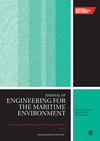A high-precision localization method for underwater targets incorporating direct path recognition and sound rays bending compensation
IF 1.5
4区 工程技术
Q3 ENGINEERING, MARINE
Proceedings of the Institution of Mechanical Engineers, Part M: Journal of Engineering for the Maritime Environment
Pub Date : 2024-08-24
DOI:10.1177/14750902241270814
引用次数: 0
Abstract
Underwater target localization technology plays a vital role in the development and utilization of marine resources. Due to the multipath effect in the hydroacoustic channel, the received signal is the superposition of a series of direct and reflected acoustic paths, making it challenging to accurately identify the direct path using existing methods. To address this issue, this paper proposes a high-precision direct path recognition method based on Light Gradient Boosting Machine (LightGBM), which utilizes the amplitude, Time of Arrival (TOA), reception angle, and phase of the received pulse as input features. Meanwhile, the direct linear conversion of acoustic wave propagation time from transmitter to receiver into a distance value, as commonly observed in radio ranging in air, is not feasible. Consequently, a method based on Effective Sound Velocity (ESV) is introduced to compensate for the bending of sound rays. By utilizing the recognized direct path delay value and the sound velocity value after compensating for sound ray bending, we can calculate the precise position of underwater targets. Experimental results validate the effectiveness of the proposed method in significantly improving the accuracy of underwater target localization.结合直接路径识别和声射线弯曲补偿的水下目标高精度定位方法
水下目标定位技术在海洋资源的开发和利用中发挥着至关重要的作用。由于水声信道中的多径效应,接收到的信号是一系列直达声路和反射声路的叠加,因此利用现有方法准确识别直达声路具有一定难度。针对这一问题,本文提出了一种基于光梯度提升机(LightGBM)的高精度直接路径识别方法,该方法利用接收脉冲的振幅、到达时间(TOA)、接收角和相位作为输入特征。同时,将声波从发射器到接收器的传播时间直接线性转换为距离值的方法并不可行,这在空气中无线电测距中很常见。因此,我们引入了一种基于有效声速(ESV)的方法来补偿声射线的弯曲。通过利用已识别的直接路径延迟值和补偿声射线弯曲后的声速值,我们可以计算出水下目标的精确位置。实验结果验证了所提方法在显著提高水下目标定位精度方面的有效性。
本文章由计算机程序翻译,如有差异,请以英文原文为准。
求助全文
约1分钟内获得全文
求助全文
来源期刊

CiteScore
3.90
自引率
11.10%
发文量
77
审稿时长
>12 weeks
期刊介绍:
The Journal of Engineering for the Maritime Environment is concerned with the design, production and operation of engineering artefacts for the maritime environment. The journal straddles the traditional boundaries of naval architecture, marine engineering, offshore/ocean engineering, coastal engineering and port engineering.
 求助内容:
求助内容: 应助结果提醒方式:
应助结果提醒方式:


